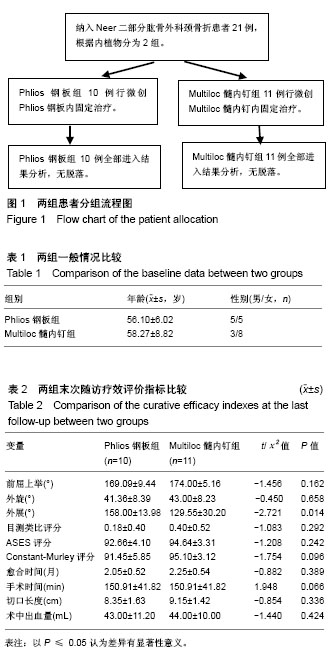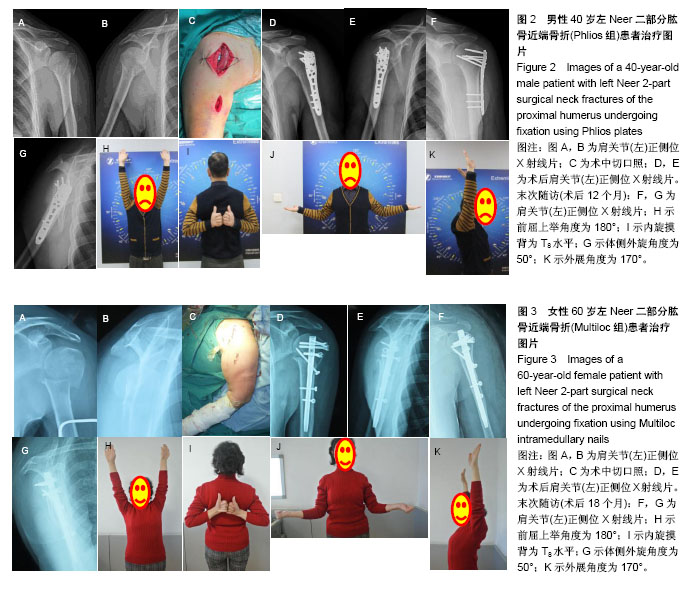| [1] Burkhart KJ, Dietz SO, Bastian L, et al. The treatment of proximal humeral fracture in adults. Dtsch Arztebl Int. 2013; 110(35-36): 591-597. [2] Lind T,Kroner K,Jensen J.The epidemiology of fractures of the proximal humerus.Arch Orthop Trauma Surg.1989;108(5): 285-287.[3] Neer CS 2nd. Displaced proximal humeral fractures. I. Classification and evaluation. J Bone Joint Surg Am. 1970; 52(6):1077-1089.[4] Horak J,Nlisson BE. Dpidemilogy of fracture of the upper end of the humerus,Clin Orthop Relat Res.1975;112:250-253.[5] Tamai K,Ishige N,Kuroda S,et al.Four-Segment classification of proximal humerus revisited:A multicenter study on 509 cases.J Shoulder Elbow Surg.2009;18(6):845-850.[6] Fakler JK, Hogan C, Heyde CE, et al.Current concepts in the treatment of proximal humeral fractures.Orthopedics. 2008; 31:42-51.[7] Robinson CM, Christie J.The two-part proximal humeral fracture:a review of operative treatment using two techniques. Injury.1993;24:123-125.[8] Hintermann B, Trouillier HH, Seh6fer D.Rigid internal fixation of fractures of the proximal humerus in older patients.J Bone Joint Surg Br. 2000;82:1107-1112.[9] Neviaser RJ,Resch H,Neviaser AS,et al .Proximal humeral fractures: pin, plate, or replace.Instr Course Lect.2015;64: 203-214.[10] 向明,杨国勇,邹义源,等.锁定钢板与髓内钉治疗肱骨近端骨折的疗效比较[J].中华骨科杂志,2017,37(21): 1333-1341 .[11] Doursounian L,Le Sant A,Mauprivez R,et al.Open reduction and internal fixation of three- and four-part proximal humeral fractures by intra-focal distraction: observational study of twenty five cases..Int Orthop.2016; 40(11):2373-2382.[12] Lebus V GF, Mir HR, Bushnell BD, et al. Reverse total shoulder arthroplasty for complex three- and four-part proximal humerus fractures in elderly patients: A Review. J Surg Orthop Adv. 2017;26(2):75-80.[13] Bogner R,Ortmaier R,Moroder P,et al.Minimally invasive treatment of displaced proximal humeral fractures in patients older than 70 years using the humerusblock. Biomed Res Int. 2016;2016:6451849.[14] 陈旭宏,鲍丰.MIPPO技术在肱骨近端骨折钢板内固定术中的应用[J]. 中国骨与关节损伤杂志,2017,32(3): 302-303.[15] 陈鹏,田晓滨.切开复位内固定与微创经皮钢板接骨术治疗复杂肱骨近端骨折的疗效比较[J].中华创伤骨科杂志,2016,18(7): 592-596.[16] Koljonen PA,Fang C,Lau TW,et al. Minimally invasive plate osteosynthesis for proximal humeral fractures. J Orthop Surg (Hong Kong).2015;23(2):160-163.[17] 杨国勇,向明,陈杭,等.Multiloc 髓内钉治疗肱骨近端骨折的近期疗效[J]. 中华骨科杂志,2016,36(2):103-112.[18] Uz A, Apaydin N, Bozkurt M,et al.The anatomic branch pattern of the axillary nerve.J Shoulder Elbow Surg. 2007; 16(2):240-244.[19] Bengard MJ, Gardner MJ.Screw depth sounding in proximal humerus fractures to avoid iatrogenic intra-articular penetration. Orthop Trauma. 2011;25(10):630-633.[20] Lanting B, MacDermid J, Drosdowech D, et al. Proximal humeral fractures: a systematic review of treatment modalities. J Shoulder Elbow Surg. 2008;17:42-54.[21] Handoll HH, Brorson S.Interventions for treating proximal humeral fractures in adults. Cochrane Database Syst Rev. 2015;(11):CD000434. [22] Bigliani LU, Flatow EL, Pollock RG. Fractures of the proximal humerus. In Rockwood and Green’s fractures in adults. 4th edition. Edited by Rockwood CA Jr, Green DP, Bucholz RW, Heckman JD. Philadelphia: Lippincott-Raven; 1996:1055-1107.[23] Maier D, Jaeger M, Izadpanah K, et al. Proximal humeral fracture treatment in adults. J Bone Joint Surg Am. 2014;96(3): 251-261. [24] Richards RR,An KN,Bigliani LU,et al. A standardized method for the assessment of shoulder function. J Shoulder Elbow Surg.1994;3(6):347-352. [25] Constant CR, Murley AH. A clinical method of functional assessment of the shoulder. Clin Orthop Relat Res.1987; (214):160-164. [26] Krettek C, Grerich T, Miclau T.A minimally invasive medial approach for proximal tibial fraaures.Injury. 2001;32(1):4-13.[27] Hettrich CM, Boraiah S, Dyke JP, et al. Quantitative assessment of the vascularity of the proximal part of the humerlls.J Bone Joint Surg Am. 2010;92(4):943-948.[28] Cetik O, Uslu M, Acar HI, et al. Is there a safe area for the axillary nerve in the deltoid muscle?A cadaveric study.J Bone Joint Surg Am. 2006;88:2395-2399.[29] Konrad G, Audigé L, Lambert S, et al. Similar outcomes for nail versus plate fixation of three-part proximal humeral fractures. Clin Orthop Relat Res. 2012;470(2): 602-609.[30] Lekic N, Montero NM, Takemoto RC, et al. Treatment of two-part proximal humerus fractures: intramedullary nail compared to locked plating. HSS J. 2012;8(2): 86-91. [31] Trepat AD, Popescu D, Fernández-Valencia JA, et al. Comparative study between locking plates versus proximal humeral nail for the treatment of 2-part proximal humeral fractures. Eur J Orthop Surg Traumatol. 2012;22(5): 373-379.[32] Gracitelli ME, Malavolta EA, Assunção JH, et al. Locking intramedullary nails compared with locking plates for two and three-part proximal humeral surgical neck fractures: a randomized controlled trial. J Shoulder Elbow Surg. 2016; 25(5):695-703.[33] Schiuma D, Plecko M, Kloub M, et al. Influence of periimplant bone quality on implant stability. Med Eng Phys. 2013;35(1): 82-87.[34] Rueger JM, Rücker A, Briem D, et al. Proximal humeral fractures: nailing. Eur J Trauma Emerg Surg. 2007;33: 357-366.[35] Liu K, Liu PC, Liu R, et al. Advantage of minimally invasive lateral approach relative to conventional deltopectoral approach for treatment of proximal humerus fractures.Med Sci Monit. 2015;21:496-504. |
.jpg)


.jpg)